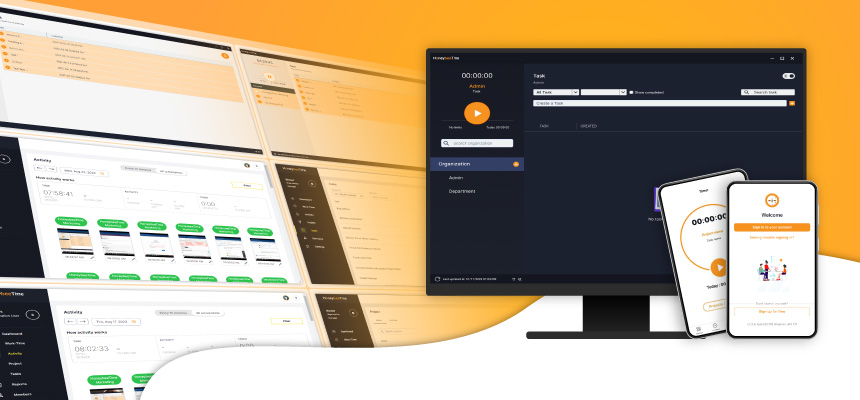Table of Contents
Rather than being seen as micromanagement, employee time tracking is a tool that can inspire workers and boost workplace efficiency. HoneybeeTime is one of the best time-tracking tools available.
Understanding the Essence of Employee Time Tracking
Employee time tracking involves documenting how much time employees spend on specific activities or projects. It can track employees' total working time, assess productivity trends, identify areas for development, and maximize project time. Many employees, however, see time tracking as micromanaging and annoying, which can lead to resistance and bad attitudes. To counter this scenario, it's critical to be honest and stress the importance of time tracking to employees, as well as build user-friendly time tracking tools and ensure that it applies to everyone in the business. When done appropriately, employee time tracking can be used to increase motivation and productivity rather than as a tool for micromanagement.
How Time Tracking Boosts Motivation and Fosters Trust
Implementing employee time monitoring may provide various advantages, including increased motivation and trust in the workplace. Here's how time monitoring may help you reach these goals:
Direct correlation between time investment and results:
Employees who measure their time may notice a clear link between the time they put into their jobs and the results they obtain. This realization might drive workers to be more focused and productive as they grasp the influence of their time on their performance.
Increased productivity and focus:
Employees must record when they begin and complete activities and their time on each job. This procedure increases employee awareness of their daily agenda and prevents multitasking and procrastination. Employees may increase their productivity and concentrate on meaningful work by minimizing these distractions.
Improved project management and supervision:
When everyone on the team tracks their time, project managers may utilize this information to handle paperwork, oversee team members, and guarantee effective project management. Time tracking records simplify the processing of documents, such as payroll calculations based on hours worked and hourly rates.
Transparency and trust-building:
Sharing time-tracking information with remote workers builds trust and develops a positive work environment. Transparency in time monitoring helps workers to realize that it applies to everyone in the business, fostering fairness and confidence.
Performance evaluation and goal progress:
Time monitoring provides managers with helpful information about the activities of employees and their progress toward targets. This data may be utilized for performance reviews, identifying areas for improvement, and offering employee feedback.
To effectively adopt time monitoring and encourage staff, it is critical to resolve concerns, communicate the advantages of time tracking, and ensure openness and fairness in its implementation. Organizations may build employee motivation and trust by stressing the benefits of time monitoring and its influence on individual and team performance.
Implementing Time Tracking without Micromanaging
The following ways may be used to implement time monitoring without micromanaging:
Leadership Participation:
Companies may successfully use time monitoring by including leadership in the process. When managers and senior executives measure their time alongside workers, it promotes a feeling of fairness and demonstrates that time tracking applies to all levels of the business.
Transparent Communication:
Employees should be informed about the purpose and advantages of time monitoring. Explain how it may increase project management efficiency and give significant information for performance assessment. Address any concerns or objections workers raise and clarify that time tracking is about boosting efficiency, not monitoring every move.
Select User-Friendly Tools:
Implement automatic time-tracking systems that gather data in the background without being noticed. Look for features such as auto start and stop timers, activity dropdown lists, and mobile access or applications that allow workers to manage their time without interfering with production.
Focus on Productivity, Not Micromanagement:
Time monitoring should not be used for micromanagement to promote productivity and efficiency. Encourage workers to log their time as a self-improvement tool to acquire insight into their daily routine and work patterns.
Provide Constructive Feedback:
Instead of utilizing time monitoring to exert control, utilize it to provide positive feedback and assistance. Monitor progress and use the data gathered to provide service, highlight areas for development, and celebrate accomplishments.
By applying these tactics, organizations may employ time monitoring to develop trust, enhance productivity, and prevent the wrong image of micromanagement.
Conclusion
Finally, integrating employee time monitoring may be an excellent tool for increasing efficiency and creating workplace trust. However, it is critical to implement time monitoring that is managed effectively. Transparent communication, leadership engagement, selecting user-friendly solutions, concentrating on productivity, and offering constructive feedback may help firms use time monitoring successfully. The objective is to highlight the benefits of time monitoring and how it affects individual and team performance while avoiding the negative image of micromanagement. Organizations may build employee motivation and trust, increasing productivity and overall success. Use the power of the HoneybeeTime Time tracking tool to maximize your success. Experience the features today: Tracking working hours, Automated Timesheets, Entering missing time manually, and a Time-tracking app for any device.




